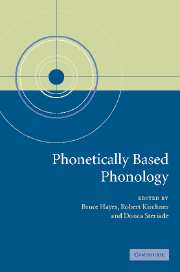Book contents
- Frontmatter
- Contents
- List of contributors
- List of abbreviations
- 1 Introduction: the phonetic bases of phonological Markedness
- 2 A review of perceptual cues and cue robustness
- 3 Place assimilation
- 4 The typology of rounding harmony
- 5 The evolution of metathesis
- 6 The role of contrast-specific and language-specific phonetics in contour tone distribution
- 7 Vowel reduction
- 8 Contrast and perceptual distinctiveness
- 9 Syllable weight
- 10 Consonant lenition
- 11 Language processing and segmental OCP effects
- Index
2 - A review of perceptual cues and cue robustness
Published online by Cambridge University Press: 21 October 2009
- Frontmatter
- Contents
- List of contributors
- List of abbreviations
- 1 Introduction: the phonetic bases of phonological Markedness
- 2 A review of perceptual cues and cue robustness
- 3 Place assimilation
- 4 The typology of rounding harmony
- 5 The evolution of metathesis
- 6 The role of contrast-specific and language-specific phonetics in contour tone distribution
- 7 Vowel reduction
- 8 Contrast and perceptual distinctiveness
- 9 Syllable weight
- 10 Consonant lenition
- 11 Language processing and segmental OCP effects
- Index
Summary
Introduction
Much recent work in phonological theory has highlighted the role that perception plays in phonological processes. The perceptual basis of contrasts and features has been explored by Flemming (1995/2002), Gordon (1999), and Kirchner (1997) among others. Other work has highlighted the role that perception can play in motivating constraints. In this approach, phonological processes such as positional neutralisation, gemination, and assimilation are motivated by interactions between the strength of perceptual cues and some notion of articulatory ease (Jun 1995; Kirchner 2000; Silverman 1997; Steriade 1995). While some would argue that permitting perceptually motivated constraints to play a role in phonological grammar introduces a prohibitive level of complexity into analyses, the (re)introduction of functionally motivated constraints permits the unification of previously disparate analyses, and in the work cited above it has reduced the number of ad hoc stipulations and exceptions necessary to capture the pattern.
The time seems ripe to revise one of the most widely used, and yet one of the most problematic, constraints in phonological theory: the Sonority Sequencing Constraint. It is almost universally recognised that the Sonority Sequencing Constraint is plagued with exceptions (see Clements 1990 for discussion) and yet most of the efforts to reform it have ended in stipulative patches rather than real improvement. The lack of success in reformulating the Sonority Sequencing Constraint stems at least in part from its greatest flaw: it lacks an explicit, unified phonetic characterisation. Previous efforts at motivating the Sonority Sequencing Constraint on typological grounds have been criticised for their lack of explanatory power and can be seen as circular in their reasoning.
- Type
- Chapter
- Information
- Phonetically Based Phonology , pp. 34 - 57Publisher: Cambridge University PressPrint publication year: 2004
- 100
- Cited by

